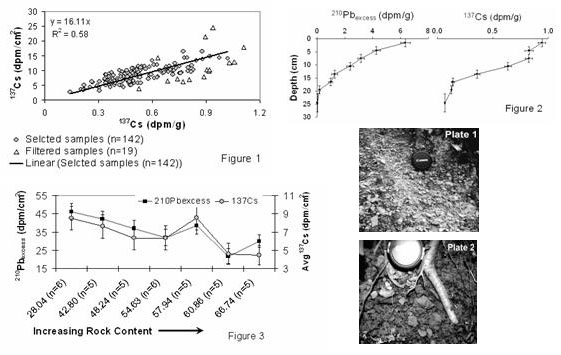
Saturday, 15 July 2006
135-29
Tracing Stochastic Behavior of Rock Bearing Soils Using 137Cs: Pinglin, NE Taiwan.
Narasimham L. Vemuri and Chih-An Huh. Institute of Earth Sciences, 128 Academia Road, PO Box 1-55, Nankang, Taipei, Taiwan
It is well established that soils containing appreciable rock content will result different total inventories for the similar activities of 137Cs (Navas and Walling, 1992), and as found in our investigations (Figure 1). Except few Mediterranean case studies, not much emphasis is given for rock-bearing soils and application of 137Cs in subtropical conditions like Taiwan. Many recent studies using 137Cs have addressed cause and effect relationship like, soil translocation by tillage, water erosion, and tracing sediment transport during storm periods. Present studies were aimed at understanding on how rock-bearing soils differ in their response to the total inventories of 137Cs for landscape conditions like, a) a cultivated terraced slope, b) a presumably undisturbed ridge, and c) along a forest slope. Hand-driven shallow soil cores (length < 40 cm and i.d. 3.4 cm) were collected from mountainous Pinglin region (24║ 56′ 07″N 121║ 41′ 26″E), the upstream end of Feitsui reservoir, Ilan County, Taiwan. The reservoir and surrounding regions experience annual mean rainfall of about 2556.5 mm (1971-2000) and is the single potable water source for Taipei metropolitan. Depth distribution and total inventories for 210Pbexcess and 137Cs were determined for ≤2 mm size fractions of the soil using three HPGe detectors (EG&G ORTEC GMX-100230), each interfaced to a stand-alone digital gamma-ray spectrometer (DSPec Plus«). Samples (n=38), collected on commercially cultivated tea-plant terraces (42░ ± 2░) have shown moderate inverse relationship between rock content and effective soil volume, indicating soil translocation and possibly selective removal of fine soil through rain-splash mechanisms. The physical evidence like high rock cover (Plate 1) and roughness on some of the terraces support soil erosion processes happening on these terraces. The forest ridge, considered as a reference site with typical depth distribution pattern for both 137Cs and 210Pbexcess (Figure 2) has shown marginal inverse relation for the nuclide total inventories with the increasing rock content (n=32), except for the peak at rock content value of 57.94% (Figure 3). The studies argue that the forest ridge has shown more nuclide-phobicity character due to random distribution of rock content at different depths and poor sorting with the associated soil. The rock content (50.31% ± 9.72) for the forest slope samples (n=118) has not shown any noticeable relation with either effective soil volume or total inventories. The studies view rock content has limited role to the size selective erosion processes of the forest slope (37░ ± 6░) due to thick vegetation unlike on the cultivated terraces. In contrast, the field observations support possibilities for physical erosion as found from the exposed tree roots grown perpendicular to the slope length. Rill erosion was observed along the tree roots grown parallel to the slope (Plate 2), and soil translocation has been evidenced through gopher(Thomomys bottae) bioturbation at the shoulder site of forest slope.

Back to 2.0P Measurement, Occurrence, and Transport of Radionuclides in Soils and Sediments, and their Transfer to Biota - Poster
Back to WCSS
Back to The 18th World Congress of Soil Science (July 9-15, 2006)